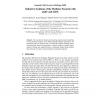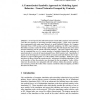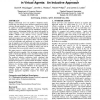284 search results - page 7 / 57 » Explanation-based Scenario Generation for Reactive System Mo... |
FMSD
2000
13 years 7 months ago
2000
We review a number of formal verification techniques supported by STeP, the Stanford Temporal Prover, describing how the tool can be used to verify properties of several versions o...
EON
2008
13 years 8 months ago
2008
We reuse here the framework, the setting, and the semantic modelling for the automated synthesis of the SWS Challenge Mediator presented in the companion paper [5], and show how to...
CONTEXT
2001
Springer
13 years 12 months ago
2001
Springer
A recent report by the National Research Council (NRC) declares neural networks “hold the most promise for providing powerful learning models”. While some researchers have expe...
ATAL
2008
Springer
13 years 9 months ago
2008
Springer
Humans continuously assess one another's situational context, modify their own affective state, and then respond based on these outcomes through empathetic expression. Virtua...
ESOP
1998
Springer
13 years 11 months ago
1998
Springer
Abstract. In the eld of reactive system programming, data ow synchronous languages like Lustre BCH+85,CHPP87 or Signal GBBG85 o er a syntax similar to block-diagrams, and can be e ...



